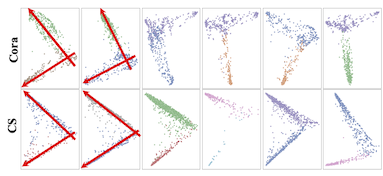Implementaion for WWW2022 paper Geometric Graph Representation Learning via Maximizing Rate Reduction [proceedings] [arxiv].
We propose Geometric Graph Representation Learning (
- We provide a Jupyter Notebook to reproduce the orthogonality visualization results (Figure 3) in Section 5.3, which shows the (nearly) orthogonality of node representations in the two classes.
- We also provide the trianing log on Cora dataset in the Jupyter Notebook.
- Requirements
torch==1.7.1
torch_geometric==1.6.3- Data
We use the dataset built in torch_geometric. The dataset will be downloaded automatically.
- Run Experiments run the following examples on Cora, CiteSeer, PubMed dataset.
python -u G2R.py --dataset Cora --num_epochs 20 --num_layers 1 --num_node_batch 768 --num_hidden 1024 --num_out 512 --gam1 0.5 --gam2 0.5 --eps 0.05 --seed 21415 --split fixedpython -u G2R.py --dataset CiteSeer --num_epochs 20 --num_layers 1 --num_node_batch 512 --num_hidden 1024 --num_out 512 --gam1 0.5 --gam2 0.5 --eps 0.1 --seed 21415 --split fixedpython -u G2R.py --dataset PubMed --num_epochs 40 --num_layers 1 --num_node_batch 200 --num_hidden 1024 --num_out 512 --gam1 0.5 --gam2 0.5 --eps 0.05 --seed 21415 --split fixedThe basic technique used in our paper originated from Learning diverse and discriminative representations via the principle of maximal coding rate reduction, Yu, Yaodong, Kwan Ho Ryan Chan, Chong You, Chaobing Song, and Yi Ma, NeurIPS2020. We would like to thank the authors for their great paper, which inspires me.
MIT
If you use this code in your research, please cite our paper.
@inproceedings{han2022geometric,
title={Geometric Graph Representation Learning via Maximizing Rate Reduction},
author={Han, Xiaotian and Jiang, Zhimeng and Liu, Ninghao and Song, Qingquan and Li, Jundong and Hu, Xia},
booktitle={Proceedings of the ACM Web Conference 2022},
pages={1226--1237},
year={2022}
}

